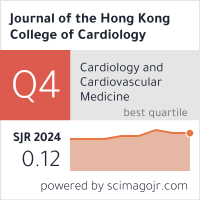Abstract
Sustained ventricular tachycardia simulated by implanted subepicardial pacing microelectrodes in 18 dogs was treated by a novel percutaneous intramyocardial chemical ablation with 100% ethanol. The ablation catheter consists of a specially designed mapping catheter and a steerable chemical ablation catheter. Ventricular tachycardia (VT) mapping and ablating manipulation was taken under the fluoroscopy in a catheterization laboratory.
Results: The success rate of chemical ablation was 100%. The induction rate of new VT was 16.7% at 4 weeks after ablation. The acute response of VT to chemical ablation included: (1) the focus was ablated completely within 3 seconds (73.3%), and (2) VT was intermittently stopped and then disappeared within 10 seconds (26.7%). The epicardium near the ablated focus changed into pale after ethanol injection. Four weeks later, the border between lesion and normal tissue became indistinct. There were normal myocardial islands in chronic fibrous lesion.
Conclusions: (1) It is feasible by using percutaneous intramyocardial chemical ablation to treat sustained VT. The success rate could get to 100% if VT focus is accurately mapped. (2) The ablating lesion can be limited in myocardial layer if the amount of chemical agent is appropriately controlled. The epicardium and endocardium near the lesion could be normal. (3) The induced VT after chemical ablation suggests the therapy may have potential long-term proarrhythmic effect.
Recommended Citation
Caiyi Lau, Xuanli Liu, Congcun Huang, Xuan Wei, Percutaneous Intramyocardial Chemical Ablation: Preliminary Results in the Treatment of Ventricular Tachycardia Model of Dogs Journal of the Hong Kong College of Cardiology 2001;9(3) https://doi.org/10.55503/2790-6744.1168
Creative Commons License

This work is licensed under a Creative Commons Attribution-Noncommercial-No Derivative Works 4.0 License.



